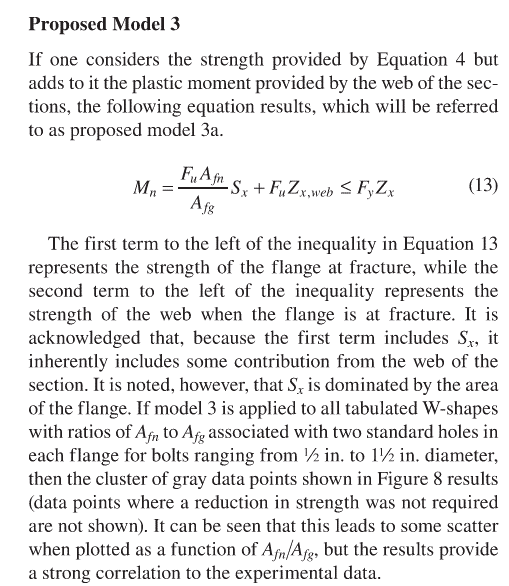Nitesh Sadashiva
Civil/Environmental
Hello all,
In one of the project there were lot of beam to column flange moment connections. Fabricator insisted on providing bolted flange plate connection between beam and column flange. Unfortunately, the moments were heavy. Providing the bolts in the beam flanges reduces the flange tension rupture capacity due to the reduction in flange area. So, we were forced to provide CJP weld at beam flanges. But the fabricator was not okay in providing CJP welds. Alternatively, we proposed beam size increment to use bolted flange plate connection. But the EOR has responded as noted below.
"Our first reaction is that the calculation the connection engineer is using to assess that the beams need to be upsized is overly conservative. Specifically, the calculation taken assumes all of the moment supported by the beams is in the flanges, and that when the bolt holes are considered, the beam doesn’t work. In fact, however, a significant amount of the moment is resisted by the beam web, so the web and the flanges share the stresses. Over the length of the connection, the moment in the web will be gradually unloaded into the flanges and the bolts. Therefore, just because the beam flanges alone would not support the moment reaction, it doesn’t mean that the bolted connection doesn’t work. We believe the vast majority if not all of the current beams should be able to be designed with moment connections without upsizing the beams. One way to look at it while maintaining the simplified force-couple approach would be to consider a portion of the web as the stem of a “T” which resists the moment, instead of just the flanges alone providing the force-couple. As you can see in the attached example calculation for one of the W30x90’s, the beam works fine when this approach is taken".
[URL unfurl="true"]https://res.cloudinary.com/engineering-com/image/upload/v1658465431/tips/Beam_Moment_Connection_-_Example_ou0jwe.pdf[/url]
I haven't seen any moment connection designed by considering the web contribution in the moment transfer. I couldn't find any supporting document to proceed this way. Did any one came across this situation? Your suggestions will help a lot.
In one of the project there were lot of beam to column flange moment connections. Fabricator insisted on providing bolted flange plate connection between beam and column flange. Unfortunately, the moments were heavy. Providing the bolts in the beam flanges reduces the flange tension rupture capacity due to the reduction in flange area. So, we were forced to provide CJP weld at beam flanges. But the fabricator was not okay in providing CJP welds. Alternatively, we proposed beam size increment to use bolted flange plate connection. But the EOR has responded as noted below.
"Our first reaction is that the calculation the connection engineer is using to assess that the beams need to be upsized is overly conservative. Specifically, the calculation taken assumes all of the moment supported by the beams is in the flanges, and that when the bolt holes are considered, the beam doesn’t work. In fact, however, a significant amount of the moment is resisted by the beam web, so the web and the flanges share the stresses. Over the length of the connection, the moment in the web will be gradually unloaded into the flanges and the bolts. Therefore, just because the beam flanges alone would not support the moment reaction, it doesn’t mean that the bolted connection doesn’t work. We believe the vast majority if not all of the current beams should be able to be designed with moment connections without upsizing the beams. One way to look at it while maintaining the simplified force-couple approach would be to consider a portion of the web as the stem of a “T” which resists the moment, instead of just the flanges alone providing the force-couple. As you can see in the attached example calculation for one of the W30x90’s, the beam works fine when this approach is taken".
[URL unfurl="true"]https://res.cloudinary.com/engineering-com/image/upload/v1658465431/tips/Beam_Moment_Connection_-_Example_ou0jwe.pdf[/url]
I haven't seen any moment connection designed by considering the web contribution in the moment transfer. I couldn't find any supporting document to proceed this way. Did any one came across this situation? Your suggestions will help a lot.

